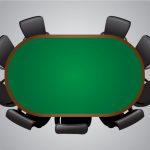In last week’s article, we looked at the basic ideas that govern game theory in poker on a conceptual level. This week, we’re going to start to look at practical applications of game theory in ways that you can apply to your game right away. To make this accessible as possible, we’re going to hold three things in mind:
- The less complicated the math involved, the better.
- This is designed for people who are playing on the low end of stakes.
- Practical application is more important than perfectly-accurate theory.
With that out of the way, let’s get started by looking at bluffing frequencies.
The Most Basic Strategic Idea in Poker
Imagine the following scenario. You’re heads-up on the river with a $10 pot and $7.50 behind, and your opponent has you covered. Your opponent checks to you with a medium-strength hand. Your range consists of the nuts and complete air, and you’ll be going all-in when you bet. Since you’ll never want to check the nuts, you’ll always be shoving with them. The question that you need to ask yourself is the following: How often should you bluff? This is by far the most basic strategic idea in poker, and if you can get a good handle on it and apply it to your game, then you will become much better in an extremely short period of time.
Imagine that you go all-in and your opponent has to decide to call or fold. If your opponent always calls, then they could be exploited by you bluffing very little. However, if your opponent always folds, then they could be exploited by you bluffing a ton. While you have to decide your bluffing frequency, your opponent has to decide on their calling frequency. These two numbers are really all you are choosing when you play poker in this particular scenario. If you can think about playing here as just the act of choosing a number for either your bluffing frequency or calling frequency, then you’ll be able to destroy the vast majority of opponents.
Correctly Using Unexploitable Frequencies
In our introduction to game theory post last week, we talked about unexploitable strategies. There are certain numbers that you can pick for the bluffing and folding frequencies in this scenario that represent the unexploitable frequencies for ourselves and our opponent, respectively. Without going into a lot of math to explain how these values are found, the unexploitable folding frequency will be bet/(bet+pot) and the unexploitable bluffing frequency will be bet/(bet+bet+pot).
In this scenario with a $10 pot and a $7.50 bet size, the unexploitable folding frequency will be 7.50/17.50 = 42.9 percent (with a calling frequency of 57.1 percent) and the unexploitable bluffing frequency will be 7.50/25 = 30.0 percent. What this means is that you’ll be unexploitable when you’re bluffing 30 percent of the time that you’re betting, and your opponent will be unexploitable when they are folding 42.9 percent of the time.
Note that this bluffing frequency means that 40 percent of the time we’re betting, our hand is a bluff. It does not mean that when we are dealt a bluffing hand, we decide to bet 30 percent of the time.
However, that doesn’t mean that you should be playing according to these numbers. Instead, you should use them as a guideline or a pivot point for how you should exploit your opponents. If you think that you should bluff a lot to exploit your opponent, then you’ll have to make sure that you’re bluffing more than 30 percent of the time that you’re betting. Along those lines, if your opponent wanted to try to exploit you by folding a lot less, then they have to make sure that they are folding less than 42.9 percent.
The unexploitable frequencies act as guidelines in a different way as well. If you think that your opponent in this situation calls more often than 42.9 percent, then you should attack them by bluffing less as an adjustment. On the other hand, if you think your opponent calls less than 42.9 percent, then you attack by bluffing more.
In this way, the unexploitable strategies also function to tell you when to exploit players and how to exploit them.
How to Play in the Example Hand
In the example hand above, we saw that we have a polarized range against a single opponent. We also saw that the bet sizes indicate that our unexploitable bluffing frequency is 30 percent with our opponent’s unexploitable folding frequency set at 42.9 percent. If you want to figure out how to play, then the first thing that you should do is evaluate how often you think your opponent is going to fold and how accurate you think that your estimate of your opponent’s folding frequency is.
Suppose we think that our opponent will fold about 35 percent of the time +/- 5 percent. This is another way of saying that we think our opponent will fold between 30 and 40 percent of the time. Then our natural way of exploiting that opponent will be to bluff less often, so we have to make sure that our bluffing frequency is lower than 30 percent.
If we wanted to exploit our opponent to the fullest, then we would never bluff when we had a chance to.
The exact amount that we decide to bluff in this situation would depend on how likely we think our opponent is to adjust and how likely we think that we could be drastically wrong about his calling frequency. The less likely he is to adjust and the less likely we are to be wrong, the more we should exploit him as much as possible by having a very low bluffing frequency.
Submit your review | |








